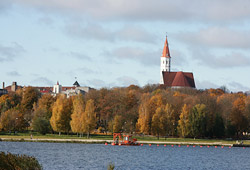History
The dates usually given for the construction of the current brick building are 1595-1625, although new studies show it may have been completed somewhat later. It replaced a small, traditional-style wooden church built in 1445. The church has suffered repeatedly amid the tumults of history, including devastation by Swedish invaders in 1656 and damages during the Great Northern War of 1700–1721. Preparations for the church’s third centenary included the reconstruction in 1924 of the lateral chapels that lacked harmony with the original renaissance tone and the straightforward cruciform floor plan.
The church especially suffered in July 1944 at the hands of retreating German soldiers. Fire destroyed the wooden parts of the structure as well as the artwork, altars, organ, furniture and balcony, and the invaluable church archive. The damaged side gables broke away from the roof and collapsed, breaking the arches of the transept. Meanwhile the floor caved in, exposing the cellar.
Reconstruction after the war proved a lengthy process. The main structural repairs were completed in 1956. Then work began to decorate and furnish the interior, renovate specific sections of the building and put the environs in order. 1974 and 1975 brought the installation of a new main altar and two side altars with a restrained neo-baroque style. Full refurbishment of the sanctuary took until 1986.
Pope John Paul II granted the church the title of Cathedral when he created the Šiauliai diocese in 1997.








